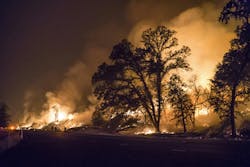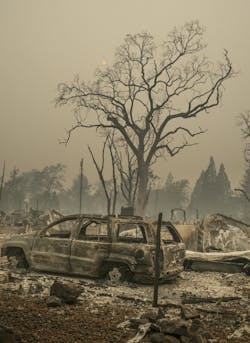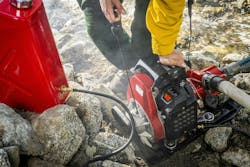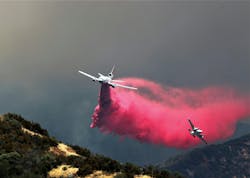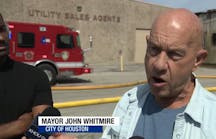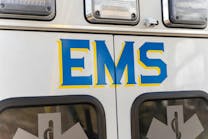Collaboration provides emergency managers resources, energy, ideas, talent, funding and time. It fosters buy-in and broadens understanding. As collaborators work together to achieve a common goal, turf battles subside, which yields a stronger, more resilient community.
The Valley Fire wasn’t just a wildfire during the 2015 California wildfire season; it was a disaster. The fire began shortly after 1 p.m. on Sept. 12 in Lake County near Cobb; by 6:30 p.m., it burned more than 10,000 acres. By Sept. 20, the fire reached 50,000 acres and destroyed much of Cobb, Middletown and Whispering Pines and parts of the southern end of Hidden Valley Lake. The rapidly moving fire ultimately spread to 76,067 acres and killed four people. At that time, it was the third-worst fire in California history based on the number of structures and buildings that were destroyed (19,055), including 1,322 homes, 27 apartment buildings and 73 businesses.
This fire relates to various aspects of emergency management studies, with the massive collaborative response following the fire being one of the most significant of those. The collective response emphasized the urgency and significance of preventing significant flooding after the fire. The area in which the fire occurred has a long history of flooding, with many severe floods occurring since 1900. This long history and a large fire scar created massive fear. The response to this fear demonstrated that the work isn’t over when the fire is extinguished.
Then and now
On Sept. 21, 2015, Gov. Edmund G. Brown Jr. requested a major disaster declaration because of the Valley Fire. The governor ordered a statewide declaration for individual assistance for Lake County and hazard mitigation. He also asked for direct federal assistance for sheltering.
During Sept. 16–20, joint federal, state and local government Preliminary Damage Assessments (PDAs) were conducted in the requested counties. On Sept. 22, then-President Barack Obama declared a major disaster in California. This declaration made individual assistance that was requested by the governor available to affected individuals and households in Lake County. The governor requested Hazard Mitigation Grant Program assistance for statewide hazard mitigation measures.
Post-wildfire emergency response work has been conducted on nonfederal lands in California in numerous ways over the past 35 years. This includes CAL FIRE emergency watershed protection evaluations in the 1980s and 1990s, which authorized the department to conduct postburn rehabilitation work. Examples of past work included spreading straw and wood mulch for erosion control in high-hazard areas. In appropriate situations, small state teams of civil engineers, geologists and CAL FIRE staff could be assembled to assess the risk to lives and property from debris and hyper-concentrated flood flows.
After the Valley Fire, the crucial role of the post-fire emergency response team was recognized. It was understood that to avoid duplication of efforts and make the most of funding opportunities, the post-fire response team needed to coordinate with and complement the efforts that were underway by National Resources Conservation Service and other state and federal agencies. A multi-agency team comprising individuals who had expertise in geology, hydrology, forestry, global information systems and water quality was assembled on Sept. 30 for the Valley Fire. This collaboration integrated various organizations and entities into day-to-day emergency management work. The collaboration joined and identified threats to watershed resources, including excessive storm erosion, impaired water quality, and threats to wildlife and fisheries. Additionally, emergency protective measures were developed and recommended to prevent identified threats; identify on-site and downstream threats to public safety; and create and recommend emergency protective measures.
Today, new life is growing within the burn scar.
Preparation and prevention
Community involvement and preparedness are crucial in mitigating wildfire risks by enhancing community resilience to wildfires, mitigating immediate effects, and contributing to long-term safety and sustainability. Creating defensible spaces, conducting controlled burns, utilizing advanced technology for early detection and rapid response, and other strategies reduce wildfire severity and lessen the need for extensive emergency response.
Creating defensible spaces involves clearing vegetation and flammable materials that are around structures, to slow fire spread and provide safer areas for firefighters.
Controlled burns, or prescribed fires, eliminate excess vegetation, which reduces fuel for larger fires and promotes fire-resistant plant growth. These carefully planned burns are executed by trained professionals to ensure safety and effectiveness.
Advanced technology, such as remote sensing, satellite imagery and drones, plays a vital role in wildfire prevention and early detection. These tools provide real-time data on vegetation conditions and potential fire risks, which enables quicker identification of fire starts and more efficient resource deployment.
Community education and awareness programs are essential for fostering a culture of preparedness. Workshops, informational campaigns and collaboration with local organizations provide what’s required to equip residents with the knowledge and skills to protect their home and family.
Leadership in crisis
Effective emergency management requires strong leadership, clear communication, decisive action, and coordinated efforts among various agencies and stakeholders. The Valley Fire response highlighted the importance of leadership in guiding collaborative efforts and ensuring a unified approach. Leaders had to assess rapidly changing conditions, deploy resources strategically and inspire teams effectively. Via clear communication, leaders ensured that emergency responders, officials and community members received accurate information to prevent misunderstandings and align efforts. Incident command systems and regular briefings maintained clear communication lines during the crisis.
Decisive action and coordination among multiple agencies were critical components of effective leadership. Leaders needed to act quickly and confidently, often with incomplete information, to make difficult decisions. They had to adapt plans as new information emerged. The collaboration among federal, state and local agencies during the Valley Fire demonstrated the importance of unified response strategies. Leaders facilitated coordination by fostering cooperation and ensuring that all efforts aligned with the overall response strategy. Successful leadership examples included well-communicated evacuation plans and the establishment of unified command centers, which enhanced resource management and decision-making.
Effect on communities
Wildfires have profound social, economic and environmental effects on communities. Immediate effects include displacement, destruction of homes and businesses, and loss of life, leading to a temporary loss of community cohesion. Economically, the costs of firefighting, property damage and loss of business income are significant. Environmental damage includes habitat loss, air quality degradation and long-term landscape changes. Recovery and rebuilding are challenging, requiring substantial time and financial resources, often hindered by bureaucratic delays and funding shortages. The Valley Fire’s aftermath highlighted community resilience and the need for sustained support from governments, nonprofits and the private sector to aid in the recovery.
The emotional and psychological toll on residents is significant, including long-lasting mental health issues, such as anxiety, depression and PTSD. It’s crucial to emphasize the importance of mental health support and community solidarity during recovery. Providing counseling services and mental health professionals, creating support groups and fostering a sense of community can help residents to cope with their experiences, navigate their complex emotions and rebuild their life. The Valley Fire highlighted the necessity of comprehensive support systems that include mental health care, community cohesion, and sustained financial and logistical assistance to help communities to recover and rebuild stronger.
Policy and legislation
Policy and legislative measures play a critical role in wildfire management. Stronger land-use regulations and building codes in fire-prone areas are essential to mitigate wildfire risks. Implementing stricter building codes can ensure that structures are more resilient to fire by incorporating fire-resistant materials and designs that reduce the likelihood of ignition. Land-use regulations can prevent development in high-risk areas, preserving natural buffers that can slow the spread of wildfires.
Increased funding for wildfire prevention and response initiatives is crucial. This includes investing in advanced technologies that help to provide early detection; improving firefighting equipment; and supporting community fire safety and preparedness education programs. Legislative support is essential to ensure that communities are better prepared for wildfires and have the necessary resources to recover swiftly.
Integrating these insights into the discussion of the Valley Fire provides a more holistic view of wildfire management. Emphasizing the importance of preparation, leadership, community effect, technological innovation and supportive policies helps to create a multifaceted approach to managing wildfires. This comprehensive strategy addresses immediate response and recovery and focuses on long-term resilience and sustainability, which ensures that communities are better equipped to handle future wildfire threats.
PRODUCT SPOTLIGHT
High-Pressure Fire Pump
The MARK-3 Watson Edition pump by WATERAX is a symbol of reliability and performance in wildland firefighting. Engineered to excel in rugged environments, it delivers high-pressure water quickly and efficiently, which is crucial for combating wildfires. Trusted by firefighters worldwide, it sets the standard for portable firefighting equipment.
Wildland Safety Goggles
Wildland Firefighting Solutions

Chad Costa
Chad Costa is the assistant chief for the Petaluma, CA, Fire Department. With more than 26 years of fire service experience, he has worked in various organizations, including CAL FIRE, rural and semi-rural districts, and a city. As a battalion chief, Costa was the technology and communications battalion chief. He is now a rostered operations branch director for CalFire Team 1 and an alternate operations section chief trainee on California Interagency Team 5. Costa is an accredited Chief Fire Officer through the Center for Public Safety Excellence and has a bachelor’s degree in emergency services management, a master’s degree in fire service leadership, and a certificate in homeland security. Costa has also completed the Executive Chief Officer Program at the National Fire Academy. Costa is a member of the Firehouse Editorial Advisory Board.
